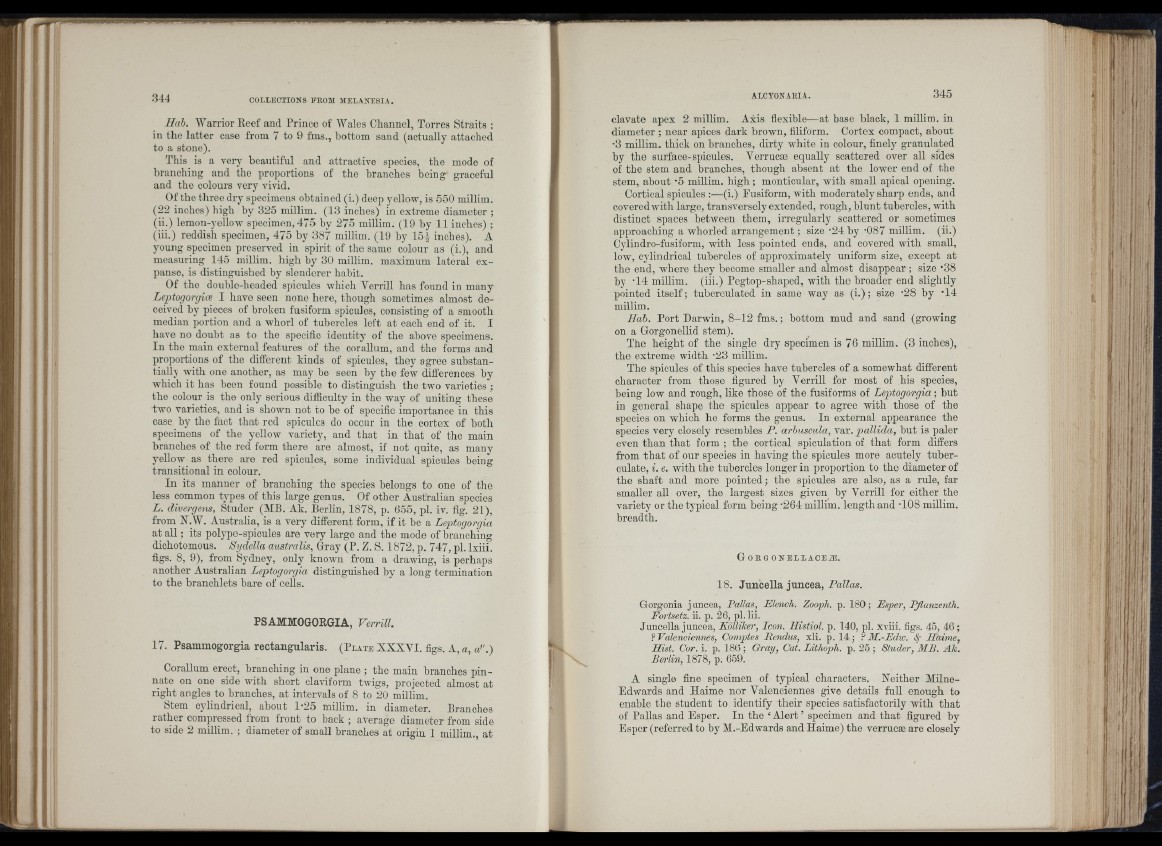
Hah. AA'arrior Keef and Prince of Waies Channel, Torres Straits ;
in the latter case from 7 to 9 fms., bottom sand (actually attached
to a stone).
This is a very beautiful and attractive species, the mode of
branching and the proportions of the branches being graceful
and the colours very vivid.
Of the three dry specimens ohtained (i.) deep yellow, is 550 millim.
(22 inches) high by 325 millim. (13 inches) in extreme diameter ;
(ii.) lemon-yellow specimen, 475 by 275 millim. (19 by 11 inches) ;
(iii.) reddish specimen, 475 by 387 millim. (19 by 15-| inches). A
young specimen preserved in spirit of the same colour as (i.), and
measuring 145 millim. high by 30 millim. maximum lateral expanse,
is distinguished by slenderer habit.
Of the double-headed spicules which Yerrill has found in many
Leptogorgim I have seen none here, though sometimes almost deceived
by pieces of broken fusiform spicules, consisting of a smooth
median portion and a whorl of tubercles left at each end of it. I
have no donht as to the specific identity of the above specimens.
In the main external features of the corallum, and the forms and
proportions of the different kinds of spicules, they agree substan-
tia llj with one another, as may be seen by the few differences by
which it has been found possible to distinguish the two varieties ;
the colour is the only serious difficulty in the way of uniting these
two varieties, and is shown not to be of specific importance in this
case by the fact th at red spicules do occur in the cortex of both
specimens of the yellow variety, and th at in th at of the main
branches of the red form there are almost, if not quite, as many
yellow as there are red spicules, some individual spicules being
transitional in colour.
In its manner of branching the species belongs to one of the
less common types of this large genus. Of other Australian species
L. divergens, Studer (MB. Ak. Berlin, 1878, p. 655, pi. iv. fig. 21),
from N.W. Australia, is a very different form, if it be a Leptogorgia
at aU ; its polype-spicules are very large and the mode of branching
dichotomous. Sydella australis, Gray (P. Z. S. 1872, p. 747, pi. Ixiii.
figs. 8, 9), from Sydney, only known from a drawing, is perhaps
another Australian Leptogorgia distinguished by a long termination
to the branchlets bare of cells.
PSAMMOGORGIA, Verrill.
17. Psammogorgia rectangularis. (P late XXXVI. figs. A, a, a''.)
Corallum erect, branching in one plane ; the main branches pinnate
on one side with short claviform twigs, projected almost at
right angles to branches, at intervals of 8 to 20 millim.
Stem cylindrical, about l ‘2o millim. in diameter. Branches
rather compressed from front to back ; average diameter from side
to side 2 millim. ; diameter of smaU branches at origin 1 millim., at
clavate apex 2 millim. Axis flexible—at base black, 1 millim. in
diameter ; near apices dark brown, filiform. Cortex compact, about
•3 millim. thick on branches, dirty white in colour, finely granulated
by the surface-spicules. Verrucæ equally scattered over all sides
of the stem and branches, though absent at the lower end of the
stem, about -5 millim. high ; monticular, with small apical opening.
Cortical spicules :—(i.) Eusiform, with moderately sharp ends, and
covered with large, transversely extended, rough, blunt tubercles, with
distinct spaces between them, irregularly scattered or sometimes
approaching a whorled arrangement ; size -24 by -087 millim. (ii.)
Cylindro-fusiform, with less pointed ends, and covered with small,
low, cylindrical tubercles of approximately uniform size, except at
the end, where they become smaller and almost disappear ; size -38
by 'I d millim. (iii.) Pegtop-shaped, with tho broader end slightly
pointed itself ; tuberculated in same way as (i.) ; size -28 by *14
millim.
Hah. Port Darwin, 8 -12 fms. ; bottom mud and sand (growing
on a Gorgonellid stem).
The height of the single dry specimen is 76 millim. (3 inches),
the extreme width -23 millim.
The spicules of this species have tubercles of a somewhat different
character from those figured by Verrill for most of his species,
being low and rough, like those of the fusiforms of Leptogorgia ; but
in general shape the spicules appear to agree with those of the
species on which he forms the genus. In external appearance the
species very closely resembles P. arhuscida, y ar. pallida, hut is paler
even than th at form ; the cortical spiculation of th a t form differs
from th a t of our species in having the spicules more acutely tuberculate,
i. 6. with the tubercles longer in proportion to the diameter of
the shaft and more pointed ; the spicules are also, as a rule, far
smaller aU over, the largest sizes given by Verrill for either the
variety or the typical form being -264 millim. length and AOS millim.
breadth.
G o r g o n e l l a c e æ .
18. Juncella juncea, Pallas.
Gorgonia juncea, Pallas, Eleneh. Zooph. p. 180; Esper, P/lanzenth.
Eoi'tsetz. ii. p. 26, pi. lii.
Juncella juncea, Kolliker, Icon. Histiol. p. 140, pi. xviii. figs. 45, 46;
? Valenciennes, Comptes Rendus, xli. p. 14 ; ? M.-Edw. Sg Haime,
Hist. Cor. i. p. 186 ; Gray, Cat. Lithoph. p. 25 ; Studer, MB. Ak.
Berlin, 1878, p. 659.
A single fine specimen of typical characters. Xeither Milne-
Edwards and Ilaime nor Valenciennes give details full enough to
enable the student to identify their species satisfactorily with th at
of Pallas and Esper. In the ‘ Alert ’ specimen and th a t figured by
Esper (referred to by M.-Edwards and Ilaime) the verrucæ are closely
' ' A ' :
; I i! :
i‘ : À*
> ! i|